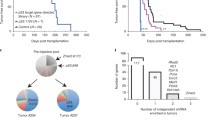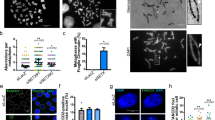Abstract
Cancer cells often contain p53 abnormalities that impair cell-cycle checkpoint progression and cause resistance to various anti-cancer treatments. DNA damage occurs at actively transcribed genes during G1-phase in yeast cells that have a deficient mRNA export capacity. Here, we show that germinal center-associated nuclear protein (GANP), a homologue of yeast Sac3 that is involved in mRNA export, is indispensable for ensuring the stability of human genomic DNA and that GANP knockdown causes apoptosis and necrosis of p53-insufficient cancer cells. Ganp small interfering RNA (siGanp)-induced DNA damage, accompanied by a decrease in the number of cells in S-phase, caused late apoptosis and necrosis in p53-insufficient cancer cells through both caspase-dependent and -independent mechanisms. siGanp effectively induced DNA damage leading to cell death in p53-insufficient cancer cells in vitro and protect the growth of cancer cells transplanted into immunocompromized mice, suggesting that siGanp has potential as a selective treatment for p53-insufficient cancer cells.





Similar content being viewed by others
Explore related subjects
Discover the latest articles and news from researchers in related subjects, suggested using machine learning.Abbreviations
- Ab:
-
Antibody
- AID:
-
Activation-induced cytidine deaminase
- BrdU:
-
Bromodeoxyuridine
- CCA:
-
Cholangiocarcinoma
- CPT:
-
Camptothecin
- C-terminal:
-
Carboxyl-terminal
- DSB:
-
Double-strand break
- GANP:
-
Germinal center-associated nuclear protein
- N-terminal:
-
Amino-terminal
- PI:
-
Propidium iodide
- siRNA:
-
Small interfering RNA
- shRNA:
-
Short hairpin RNA
- Wt:
-
Wild-type
References
Méchali M (2010) Eukaryotic DNA replication origins: many choices for appropriate answers. Nat Rev Mol Cell Biol 11:728–738
Maslov AY, Vijg J (2009) Genome instability, cancer and aging. Biochim Biophys Acta 1790:963–969
Sancar A, Lindsey-Boltz LA, Unsal-Kaçmaz K, Linn S (2004) Molecular mechanisms of mammalian DNA repair and the DNA damage checkpoints. Annu Rev Biochem 73:39–85
Niida H, Nakanishi M (2006) DNA damage checkpoints in mammals. Mutagenesis 21:3–9
Perez-Losada J, Mao J-H, Balmain A (2005) Control of genomic instability and epithelial tumor development by the p53-Fbxw7/Cdc4 pathway. Cancer Res 65:6488–6492
Harper JW, Elledge SJ (2007) The DNA damage response: ten years after. Mol Cell 28:739–745
Rondón AG, Jimeno S, Aguilera A (2010) The interface between transcription and mRNP export: from THO to THSC/TREX-2. Biochim Biophys Acta 1799:533–538
Fischer T, Strässer K, Rácz A, Rodriguez-Navarro S, Oppizzi M, Ihrig P, Lechner J, Hurt E (2002) The mRNA export machinery requires the novel Sac3p–Thp1p complex to dock at the nucleoplasmic entrance of the nuclear pores. EMBO J 21:5843–5852
Rodríguez-Navarro S, Fischer T, Luo MJ, Antúnez O, Brettschneider S, Lechner J, Pérez-Ortín JE, Reed R, Hurt E (2004) Sus1, a functional component of the SAGA histone acetylase complex and the nuclear pore-associated mRNA export machinery. Cell 116:75–86
Gallardo M, Luna R, Erdjument-Bromage H, Tempst P, Aguilera A (2003) Nab2p and the Thp1p-Sac3p complex functionally interact at the interface between transcription and mRNA metabolism. J Biol Chem 278:24225–24232
Aguilera A, Gómez-González B (2008) Genome instability: a mechanistic view of its causes and consequences. Nat Rev Genet 9:204–217
Kuwahara K, Yoshida M, Kondo E et al (2000) A novel nuclear phosphoprotein, GANP, is up-regulated in centrocytes of the germinal center and associated with MCM3, a protein essential for DNA replication. Blood 95:2321–2328
Kuwahara K, Tomiyasu S, Fujimura S, Nomura K, Xing Y, Nishiyama N, Ogawa M, Imajoh-Ohmi S, Izuta S, Sakaguchi N (2001) Germinal center-associated nuclear protein (GANP) has a phosphorylation-dependent DNA-primase activity that is up-regulated in germinal center regions. Proc Natl Acad Sci USA 98:10279–10283
Kuwahara K, Fujimura S, Takahashi Y, Nakagata N, Takemori T, Aizawa S, Sakaguchi N (2004) Germinal center-associated nuclear protein contributes to affinity maturation of B cell antigen receptor in T cell-dependent responses. Proc Natl Acad Sci USA 101:1010–1015
Takei Y, Swietlik M, Tanoue A, Tsujimoto G, Kouzarides T, Laskey R (2001) MCM3AP, a novel acetyltransferase that acetylates replication protein MCM3. EMBO Rep 2:119–123
Abe E, Kuwahara K, Yoshida M, Suzuki M, Terasaki H, Matsuo Y, Takahashi EI, Sakaguchi N (2000) Structure, expression, and chromosomal localization of the human gene encoding a germinal center-associated nuclear protein (GANP) that associates with MCM3 involved in the initiation of DNA replication. Gene 255:219–227
Bermejo R, Capra T, Jossen R et al (2011) The replication checkpoint protects fork stability by releasing transcribed genes from nuclear pores. Cell 146:233–246
Okamoto N, Kuwahara K, Ohta K, Kitabatake M, Takagi K, Mizuta H, Kondo E, Sakaguchi N (2010) Germinal center-associated nuclear protein (GANP) is involved in mRNA export of Shugoshin-1 required for centromere cohesion and in sister-chromatid exchange. Genes Cells 15:471–484
Yoshida M, Kuwahara K, Shimasaki T, Nakagata N, Matsuoka M, Sakaguchi N (2007) GANP suppresses DNA recombination measured by direct-repeat β-galactosidase gene-construct but does not suppress the type of recombination applying to immunoglobulin genes in mammalian cells. Genes Cells 12:1205–1213
Bauer A, Kölling R (1996) The SAC3 gene encodes a nuclear protein required for normal progression of mitosis. J Cell Sci 109:1575–1583
Ohta K, Kuwahara K, Zhang Z, Makino K, Komohara Y, Nakamura H, Kuratsu J, Sakaguchi N (2009) Decreased expression of germinal center-associated nuclear protein is involved in chromosomal instability in malignant gliomas. Cancer Sci 100:2069–2076
Izquierdo M (2005) Short interfering RNAs as a tool for cancer gene therapy. Cancer Gene Ther 12:217–227
Degenhardt Y, Lampkin T (2010) Targeting Polo-like kinase in cancer therapy. Clin Cancer Res 16:384–389
Sripa B, Kaewkes S, Sithithaworn P et al (2007) Liver fluke induces cholangiocarcinoma. PLOS Med 4:e201
Khan SA, Thomas HC, Toledano M, Cox IJ, Taylor-Robinson SD (2005) p53 mutations in human cholangiocarcinoma: a review. Liver Int 25:704–716
Chan-On W, Kuwahara K, Kobayashi N, Ohta K, Shimasaki T, Sripa B, Leelayuwat C, Sakaguchi N (2009) Cholangiocarcinomas associated with long-term inflammation express the activation-induced cytidine deaminase and germinal center-associated nuclear protein involved in immunoglobulin V-region diversification. Int J Oncol 35:287–295
Sripa B, Leungwattanawanit S, Nitta T, Wongkham C, Bhudhisawasdi V, Puapairoj A, Sripa C, Miwa M (2005) Establishment and characterization of an opisthorchiasis-associated cholangiocarcinoma cell line (KKU-100). World J Gastroenterol 11:3392–3397
Ono A, Hattori S, Kariya R, Iwanaga S, Taura M, Harada H, Suzu S, Okada S (2011) Comparative study of human hematopoietic cell engraftment into Balb/c and C57BL/6 strain of Rag-2/Jak3 double-deficient mice. J Biomed Biotechnol 2011:539748
Kessis TD, Slebos RT, Nelson WG, Kastan MB, Plunkett BS, Han SM, Lorincz AT, Hedrick L, Cho KR (1993) Human papillomavirus 16 E6 expression disrupts the p53-mediated cellular response to DNA damage. Proc Natl Acad Sci USA 90:3988–3992
Galluzzi L, Vanden Berghe T, Vanlangenakker N, Buettner S, Eisenberg T, Vandenabeele P, Madeo F, Kroemer G (2011) Programmed necrosis from molecules to health and disease. Int Rev Cell Mol Biol 289:1–35
Silva MT (2010) Secondary necrosis: the natural outcome of the complete apoptotic program. FEBS Lett 584:4491–4499
Shen Y, White E (2001) p53-dependent apoptosis pathways. Adv Cancer Res 82:55–84
Jin S, Fan F, Fan W, Zhao H, Tong T, Blanck P, Alomo I, Rajasekaran B, Zhan Q (2001) Transcription factors Oct-1 and NF-YA regulate the p53-independent induction of the GADD45 following DNA damage. Oncogene 20:2683–2690
Kato S, Han SY, Liu W, Otsuka K, Shibata H, Kanamaru R, Ishioka C (2003) Understanding the function-structure and function-mutation relationships of p53 tumor suppressor protein by high-resolution missense mutation analysis. Proc Natl Acad Sci USA 100:8424–8429
Pavletich NP, Chambers KA, Pabo CO (1993) The DNA-binding domain of p53 contains the four conserved regions and the major mutation hot spots. Genes Dev 7:2556–2564
Bargonetti J, Manfredi JJ, Chen X, Marshak DR, Prives C (1993) A proteolytic fragment from the central region of p53 has marked sequence-specific DNA-binding activity when generated from wild-type but not from oncogenic mutant p53 protein. Genes Dev 7:2565–2574
Maeda K, Singh SK, Eda K, Kitabatake M, Pham P, Goodman MF, Sakaguchi N (2010) GANP-mediated recruitment of activation-induced cytidine deaminase to cell nuclei and to immunoglobulin variable region DNA. J Biol Chem 285:23945–23953
Rothenberg ML (1997) Topoisomerase I inhibitors: review and update. Ann Oncol 8:837–855
Dykxhoorn DM, Palliser D, Lieberman J (2006) The silent treatment: siRNAs as small molecule drugs. Gene Ther 13:541–552
Kim SS, Garg H, Joshi A, Manjunath N (2009) Strategies for targeted nonviral delivery of siRNAs in vivo. Trends Mol Med 15:491–500
Scherr M, Morgan MA, Eder M (2003) Gene silencing mediated by small interfering RNAs in mammalian cells. Curr Med Chem 10:245–256
Acknowledgments
We would like to thank Mika Ito and Yoshimi Fukushima for technical assistance. This work was supported by a Grant-in-Aid for Science Research in a Priority Area (Immunology Community) from the Ministry of Education, Culture, Sports, Science and Technology (MEXT) (to N.S.), Advanced Education Program for Integrated Clinical, Basic and Social Medicine, Graduate School of Medical Sciences, Kumamoto University (Program for Enhancing Systematic Education in Graduate Schools, MEXT) (to N.S.), the Adaptable and Seamless Technology Transfer Program through Target-driven R&D (Japan Science and Technology Agency) (to K.K.), Heiwa Nakajima Foundation (to S.O., K.V., and K.K.), a contract research fund from the Program of Founding Research Centers for Emerging and Reemerging Infectious Diseases (to N.S.), and a Global COE program (Global Education and Research Center Aiming at the control of AIDS in Kumamoto University) (to N.S.). Suchada Phimsen is supported by a scholarship for The International Priority Graduate Programs (PGP); Advanced Graduate Courses for International Students (Doctoral Course), MEXT, Japan.
Conflict of interest
None.
Author information
Authors and Affiliations
Corresponding author
Electronic supplementary material
Below is the link to the electronic supplementary material.
Rights and permissions
About this article
Cite this article
Phimsen, S., Kuwahara, K., Nakaya, T. et al. Selective cell death of p53-insufficient cancer cells is induced by knockdown of the mRNA export molecule GANP. Apoptosis 17, 679–690 (2012). https://doi.org/10.1007/s10495-012-0711-8
Published:
Issue Date:
DOI: https://doi.org/10.1007/s10495-012-0711-8
Keywords
Profiles
- Andri Rezano View author profile
- Kulthida Vaeteewoottacharn View author profile




